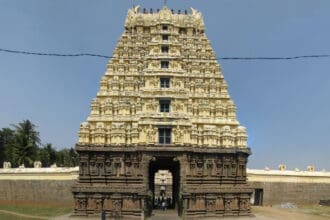Nestled along the Coromandel Coast of Tamil Nadu, Mahabalipuram stands as a timeless testament to India’s rich cultural and architectural heritage. Known for its UNESCO World Heritage Sites, this ancient port city is home to some of the most exquisite rock-cut cave temples in the world. These Cave Temples of Mahabalipuram , carved out of solid granite during the Pallava dynasty (7th–8th century CE), are not only architectural wonders but also repositories of history, mythology, and artistry. In this article, we delve into the enchanting marvels of these cave temples, exploring their history, significance, intricate carvings, and enduring legacy.
Introduction to the Cave Temples of Mahabalipuram
A Glimpse into Mahabalipuram’s Glory
Mahabalipuram, also known as Mamallapuram , was once a bustling seaport under the reign of the Pallava dynasty. It served as a hub for maritime trade and cultural exchange between India and Southeast Asia. The city’s prominence during this period is reflected in its magnificent monuments, including the iconic Shore Temple , the Five Rathas , and the awe-inspiring Cave Temples .
The Cave Temples of Mahabalipuram are a collection of monolithic structures carved directly into the rocky hillsides. These temples are remarkable for their intricate sculptures, elaborate bas-reliefs, and innovative architectural techniques. Each temple tells a story, whether through depictions of Hindu deities, mythological narratives, or scenes of daily life from the Pallava era.
Why Visit the Cave Temples?
Visiting the Cave Temples of Mahabalipuram is like stepping back in time to an era of unparalleled craftsmanship and devotion. These temples offer a unique blend of spirituality, art, and history, making them a must-see destination for travelers, historians, and art enthusiasts alike. Their serene ambiance, coupled with the stunning coastal backdrop, creates an unforgettable experience that lingers long after your visit.
Historical Significance of the Cave Temples
The Pallava Dynasty and Architectural Innovation
The Cave Temples of Mahabalipuram owe their existence to the visionary kings of the Pallava dynasty, particularly Narasimhavarman I (also known as Mamalla) and his successors. Under their patronage, Mahabalipuram became a center for artistic and architectural experimentation. The Pallavas were pioneers in rock-cut architecture, blending traditional Dravidian styles with innovative techniques to create structures that have stood the test of time.
These cave temples were primarily built as places of worship and meditation. They served as sanctuaries for devotees seeking spiritual enlightenment and as venues for royal ceremonies. The temples also played a crucial role in promoting Hinduism, Buddhism, and Jainism, reflecting the religious diversity of the region during the Pallava era.
Influence on Later Architecture
The architectural innovations introduced at the Cave Temples of Mahabalipuram had a profound influence on later temple designs across South India. The use of monolithic rock-cut structures, intricate carvings, and symbolic motifs set a precedent for the development of Dravidian temple architecture. Many of the techniques and styles seen in these caves can be traced in the grand temples of Kanchipuram, Thanjavur, and Madurai.
Exploring the Major Cave Temples of Mahabalipuram
1. Varaha Cave Temple: A Testament to Divine Power
Architecture and Layout
The Varaha Cave Temple is one of the most celebrated cave temples in Mahabalipuram. Dedicated to Lord Vishnu, it features a simple yet elegant design with a pillared mandapa (hall) and a sanctum sanctorum. The facade of the temple is adorned with intricately carved pillars, each depicting scenes from Hindu mythology.
Iconic Sculptures
The highlight of the Varaha Cave Temple is the depiction of Lord Vishnu in his Varaha avatar (boar incarnation). This sculpture shows Vishnu rescuing Goddess Bhudevi (Mother Earth) from the depths of the cosmic ocean, symbolizing the triumph of good over evil. Another notable carving is the portrayal of Durga as Mahishasuramardini , slaying the buffalo demon Mahishasura. These sculptures are masterpieces of Pallava art, showcasing the skill and precision of the artisans.
Symbolism and Devotion
The themes depicted in the Varaha Cave Temple reflect the Pallavas’ deep devotion to Lord Vishnu and their belief in the protective power of divine avatars. The temple serves as a reminder of the eternal struggle between righteousness and chaos, inspiring visitors to embrace virtues like courage and compassion.
2. Krishna Mandapam: Celebrating Life and Nature
Scenic Depictions
The Krishna Mandapam is renowned for its breathtaking bas-relief panels that depict scenes of rural life and pastoral beauty. One of the most famous carvings shows Lord Krishna lifting the Govardhan Hill to protect his devotees from torrential rains sent by Indra, the god of rain. This scene captures the essence of Krishna’s playful yet powerful nature.
Artistic Mastery
The attention to detail in the Krishna Mandapam is extraordinary. Every element, from the expressions on the faces of the villagers to the folds of their clothing, is meticulously crafted. The lush landscapes and grazing cattle add a sense of vitality and harmony to the composition.
Cultural Insights
Beyond its artistic brilliance, the Krishna Mandapam provides valuable insights into the agrarian lifestyle of the Pallava period. It highlights the importance of agriculture, community bonding, and the harmonious coexistence of humans and nature.
3. Mahishasuramardini Cave: A Celebration of Feminine Strength
Dedication to Goddess Durga
The Mahishasuramardini Cave is dedicated to Goddess Durga, who is revered as the destroyer of evil. The temple’s walls are adorned with dramatic carvings of Durga battling the buffalo demon Mahishasura. Her fierce expression and dynamic posture convey her determination and strength.
Other Highlights
Another striking feature of the Mahishasuramardini Cave is the depiction of Lord Vishnu reclining on Adishesha , the serpent king. This serene image represents cosmic balance and the cyclical nature of creation, preservation, and destruction.
Spiritual Lessons
The Mahishasuramardini Cave embodies the theme of feminine empowerment and divine intervention. It teaches the importance of inner strength, resilience, and faith in overcoming challenges.
4. Panchapandava Cave: Legends of the Pandavas
Mythological Connections
The Panchapandava Cave is named after the five Pandava brothers from the Mahabharata. While there is no direct evidence linking the cave to the epic, its name reflects the Pallavas’ fascination with Hindu mythology.
Architectural Features
This cave temple features a spacious hall supported by elegantly carved pillars. The interior walls are adorned with carvings of deities, celestial beings, and floral motifs. The simplicity of the design contrasts with the complexity of the sculptures, creating a harmonious balance.
Symbolic Interpretations
The Panchapandava Cave is believed to symbolize the virtues of dharma (righteousness), artha (wealth), kama (desire), and moksha (liberation). Its serene atmosphere invites visitors to reflect on these principles and their relevance to modern life.
5. Tiger Cave: A Unique Amphitheater
Distinctive Design
Unlike the other cave temples, the Tiger Cave is an open-air structure resembling an amphitheater. Its entrance is flanked by carvings of tiger-like creatures, giving the site its name. Historians believe it may have served as a venue for royal performances or rituals.
Mystery and Speculation
The exact purpose of the Tiger Cave remains a mystery. Some scholars suggest it was used for dance and music recitals, while others propose it had religious significance. Regardless of its original function, the Tiger Cave continues to captivate visitors with its enigmatic charm.
Natural Beauty
Surrounded by lush greenery and rocky terrain, the Tiger Cave offers a picturesque setting for exploration and photography. Its proximity to the beach adds to its appeal, making it a popular spot for both tourists and locals.
Architectural Techniques and Artistic Excellence
Rock-Cut Mastery
The Cave Temples of Mahabalipuram exemplify the pinnacle of rock-cut architecture. Using rudimentary tools, the Pallava artisans carved entire temples out of solid granite, creating spaces that are both functional and aesthetically pleasing. The precision and symmetry of the structures are a testament to their technical expertise.
Sculptural Brilliance
The sculptures found in these cave temples are nothing short of extraordinary. From the lifelike depictions of deities to the intricate detailing of ornaments and garments, every carving reflects the artisans’ mastery over their craft. The interplay of light and shadow enhances the visual impact of the sculptures, bringing them to life.
Symbolism and Storytelling
Each sculpture and motif in the cave temples carries deep symbolic meaning. Whether it’s the depiction of divine avatars, mythological battles, or everyday life, these artworks serve as visual narratives that educate and inspire. They also highlight the Pallavas’ commitment to preserving and promoting Hindu traditions.
The Spiritual Essence of the Cave Temples
A Place of Worship and Reflection
For centuries, the Cave Temples of Mahabalipuram have been sacred spaces where devotees seek blessings and solace. The tranquil environment, combined with the divine energy of the temples, fosters a sense of peace and introspection. Visitors often describe their experience as transformative, leaving them with a renewed sense of purpose and clarity.
Connection to Nature
The integration of the cave temples with their natural surroundings underscores the Pallavas’ reverence for nature. The rocky hills, verdant foliage, and nearby sea create a harmonious backdrop that enhances the spiritual ambiance of the temples.
How to Reach the Cave Temples of Mahabalipuram
Reaching the Cave Temples of Mahabalipuram is convenient, thanks to its proximity to Chennai, the capital of Tamil Nadu. The town is located approximately 60 kilometers south of Chennai and is well-connected by road and rail.
By Road
You can hire a taxi or take a bus from Chennai to Mahabalipuram. The East Coast Road (ECR), which runs along the coastline, offers a scenic drive with stunning views of the Bay of Bengal.
By Train
The nearest railway station is Chengalpattu, about 30 kilometers away. From there, you can hire a cab or take a local bus to reach Mahabalipuram.
By Air
The nearest airport is Chennai International Airport. From the airport, you can hire a taxi or take a pre-booked car to Mahabalipuram.
Conclusion
The Cave Temples of Mahabalipuram are more than just architectural marvels; they are living embodiments of India’s glorious past. Their intricate carvings, profound symbolism, and serene beauty continue to inspire awe and admiration among visitors from around the world. Whether you’re a history buff, an art lover, or a spiritual seeker, these temples offer a journey into the heart of creativity and devotion.
“In the silence of the cave temples, echoes of ancient wisdom resonate, inviting us to connect with the divine.”
We hope this article has inspired you to explore the enchanting marvels of the Cave Temples of Mahabalipuram . May your visit be filled with wonder, discovery, and spiritual fulfillment.
Frequently Asked Questions (FAQs)
- What are the main attractions of Mahabalipuram?
- The Shore Temple, Five Rathas, Cave Temples, and Arjuna’s Penance.
- Are the Cave Temples of Mahabalipuram open to all religions?
- Yes, they welcome people of all faiths.
- What is the best time to visit Mahabalipuram?
- October to March, when the weather is pleasant.
- How old are the Cave Temples of Mahabalipuram?
- They date back to the 7th–8th century CE.
- Is photography allowed inside the cave temples?
- Yes, but flash photography may be restricted.
- Who built the Cave Temples of Mahabalipuram?
- They were constructed during the Pallava dynasty.
- Are there guided tours available for the cave temples?
- Yes, professional guides are available at the site.
- What is the significance of the Varaha Cave Temple?
- It celebrates Lord Vishnu’s Varaha avatar and his role as a protector.
- Can I visit Mahabalipuram as a day trip from Chennai?
- Yes, it is a popular day-trip destination.
- Are there accommodations near the Cave Temples?
- Yes, several hotels and resorts are available in Mahabalipuram.



















